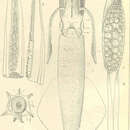en
names in breadcrumbs


Doryteuthis genera take part in year-round egg-spawning, with peaks in the month of May and hatching in July (Jacobson 2005). Competitions for mating are regulated by chemical and visual cues. For periods of up to several weeks, females may lay multiple clutches of eggs that can include multiple fathers from different spawning events. It has also been found that females may keep some sperm from the spawning events to use later (Jacobson 2005). The egg cases, when fertilized following a spawning event, are deposited onto ocean floor for 6-12 weeks, hatching earlier if temperatures are warmer and later if colder (Zeidberg et al. 2011). Egg cases have been found at depths from 13-93m. It has been found that the substrate eggs are found on (sand) and the temperature of seawater serve as spawning-stimulating behavioral cues. The lifespan of Doryteuthis does not exceed one year. (Zeidberg et al. 2001)
Doryteuthis is a genus of squid from the waters of the western Atlantic and eastern Pacific off the coast of the Americas species are the common inshore squids of American waters. Some species are important quarry species for fisheries.[2]
In Doryteuthis the tentacular clubs are expanded and bear suckers in 4 series. The hectocotylus is on the left ventral arm IV with unmodified suckers near the base, lack of a ventral crest while the reduced on elongated stalks form papillae on the dorsal series or on both dorsal and ventral series. The fins are situated in a posterior position. The spermatophore has a short, cement body cement body and they do not have any photophores.[3]
Doryteuthis is divided into two subgenera, Amerigo and Doryteuthis. The species in each subgenus are:[1]
Doryteuthis is a genus of squid from the waters of the western Atlantic and eastern Pacific off the coast of the Americas species are the common inshore squids of American waters. Some species are important quarry species for fisheries.
In Doryteuthis the tentacular clubs are expanded and bear suckers in 4 series. The hectocotylus is on the left ventral arm IV with unmodified suckers near the base, lack of a ventral crest while the reduced on elongated stalks form papillae on the dorsal series or on both dorsal and ventral series. The fins are situated in a posterior position. The spermatophore has a short, cement body cement body and they do not have any photophores.